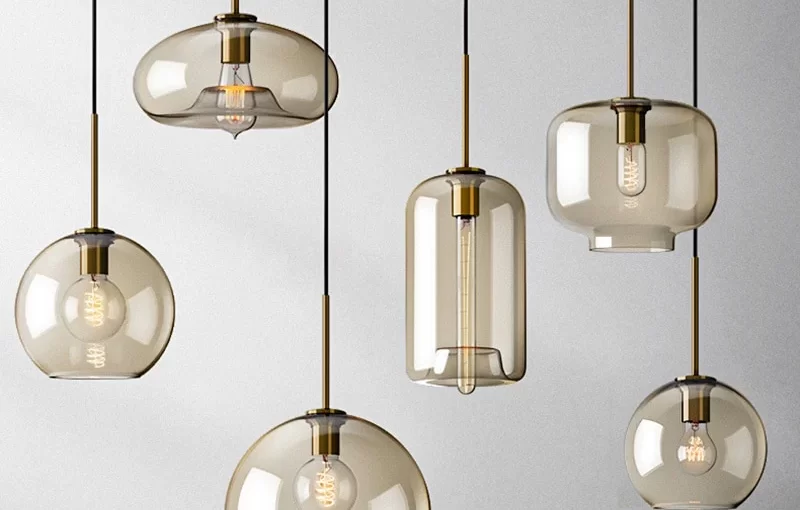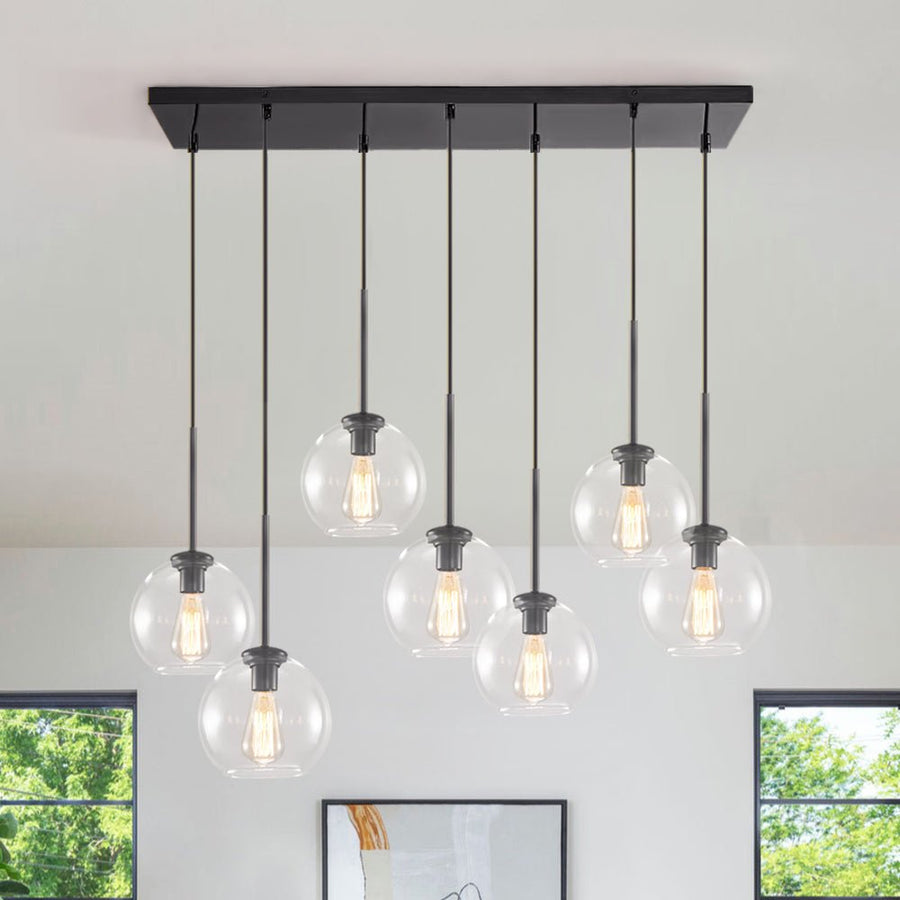Introduction to Pendant Lights
Pendant lights are unique fixtures that add both illumination and style to a space. Suspended from the ceiling, they hang on chains, cords, or metal rods. Diverse in design, pendant lights are known for their adaptability to different settings, from cozy homes to bustling cafes. They are not only functional but also serve as a decorative element, offering a way to express personal style through lighting.
Pendant lights often feature a single bulb, although some designs may have multiple bulbs for a broader light spread. They come in various materials including glass, metal, plastic, and paper, leading to an array of styles. With shapes ranging from sleek globes to intricate cages, pendant lights cater to a variety of tastes. Some people opt for custom designs to perfectly match their decor preferences.
Beyond aesthetics, pendant lights are versatile in their usage. They can provide general lighting that brightens an entire room, area lighting that accentuates a specific part, or task lighting that focuses on a workspace. Whether choosing a pendant light for practicality or design, there is a suitable option for every need.
In the next sections, we’ll delve deeper into the key characteristics of pendant lighting, the materials used, the types available, and practical tips for their installation and use. By understanding what is a pendant light, you can make informed decisions on how to best light up your space.
Key Characteristics of Pendant Lighting
Pendant lighting stands out for its blend of function and style. These fixtures are distinguished by their suspended design, often hanging from a chain, cord, or metal rod. Key characteristics define what is a pendant light:
- Single Light Source: Most pendant lights typically have one bulb. This focus creates a spotlight effect or a soft glow, depending on the chosen style.
- Variety of Materials: Pendant lights are made from materials like glass, metal, plastic, and paper. Each material offers a different look and feel, influencing the light’s diffusion and the atmosphere it creates.
- Customizable Shapes and Designs: From simple globes to intricate cages, pendants are available in countless shapes. Companies even offer custom designs to suit unique preferences.
- Adaptable to Many Settings: Whether it’s for home, office, or a public space, pendant lights can complement any decor. They’re perfect for general, area, or task lighting, adding a touch of elegance wherever they are placed.
- Aesthetic Appeal: Pendant lights are more than just light sources; they’re a part of the room’s decor. They can act as a focal point or complement the interior design scheme.
In the heart of pendant lighting lies its versatility and the ability to enhance any space aesthetically and functionally. Next, we’ll explore the various materials used in pendant lighting, each bringing its own unique qualities to the mix.
The Various Materials Used in Pendant Lighting
Pendant lights come in different materials, each adding its own touch to your space. Let’s look at the common ones you’ll find:
- Glass: Glass pendant lights are popular for their ability to brighten a room while offering many design choices, from clear to coloured finishes.
- Metal: Metal pendants are durable and provide a modern or industrial look for any room. You can find them in finishes like copper, brass, or steel.
- Plastic: Plastic pendants are a cost-effective option. They come in various colors and styles, perfect for a playful or modern vibe.
- Paper: Paper pendant lights give a soft, warm glow and can bring an artistic feel to a space. They’re light and often come in unique shapes.
Each material has its own benefits and can set the mood in a room. Glass can create a clean and elegant atmosphere, while metal can be sleek or rugged. Plastic offers versatility and paper can be quite eco-friendly and artistic. When choosing a pendant light, think about the look you’re going for and how the light’s material will add to it. In the next section, we’ll explore the different types of pendant lights to further guide your selection.
Types of Pendant Lights
Pendant lights come in various types, each offering a unique look and functionality. Understanding the different styles helps you choose the right one for your space.
Glass Pendant Lights
Glass pendant lights are a favorite for their versatile design options. They can cast bright or soft light, depending on the finish – clear, frosted, or colored. Glass pendants can suit any room, adding elegance and charm.
Multi-Light Pendants
Multi-light pendants feature several bulbs, often connected to a central fixture. They serve well for lighting up large areas or for making a bold statement in a room. These pendants can have shades or be bare, each style changing the light’s effect.
Drum Shade and Globe Pendants
Drum shade pendants have cylindrical shades that offer a soft, diffused light, perfect for cozy spaces. Globe pendants have spherical shades, often clear or frosted, casting even light in all directions, ideal for general lighting.
Linear and Cord Pendants
Linear pendants are simple, with long bulbs on slender canopies. They are great over kitchen islands or dining tables. Cord pendants are minimalist, usually just a bulb on a pendant cord, and work well for a subtle look or smaller spaces.
Shade and Lantern Pendants
Shade pendants can have a variety of shades, from metal to fabric, each creating a different mood. Lantern pendants are vintage in look, often with clear glass panels, and can add character to a variety of decors.
By recognizing the diverse types of pendant lights, you can align your choice with the desired ambiance and functionality for your space.
Where to Use Pendant Lights
Pendant lights are versatile and can be used in various settings to enhance the ambience and functionality of a space. Whether looking to cast a wide glow over a room or concentrate light over a specific area or task, pendant lights can be strategically placed to meet lighting needs. In this section, we’ll explore the different applications of pendant light usage.
General Lighting
General lighting refers to the overall illumination of a space. Pendant lights are ideal for providing this kind of lighting when suspended at a strategic central point. They can be placed in living rooms, bedrooms, or entryways to create a warm, welcoming environment. When used as general lighting, the goal is to offer consistent light that spreads throughout the entire area.
Area Lighting
Area lighting focuses on a particular section of a room. It’s perfect for highlighting specific features like art pieces, dining tables or a cozy reading nook. Pendant lights shine in these scenarios, offering directed light that can draw attention to the intended space. They work well above counters in kitchens or desks in home offices, providing both function and style to these zones.
Task Lighting
Task lighting ensures sufficient, direct light for activities like reading, cooking, or working. A pendant light placed over a workspace like a kitchen island or a study desk provides focused illumination, making tasks easier and reducing strain on the eyes. For task lighting, consider the height at which the pendant is hung to maximize its effectiveness without causing glare or casting unwanted shadows.
Installation Tips for Pendant Lighting
Installing pendant lights may seem daunting, but with some guidance, it can be straightforward.
Choose the Right Height
Selecting the proper height is crucial. Hang your pendant light so it lights the area well.
Consider the Pendant’s Purpose
Match the light’s height to its purpose. For task lighting, it should be lower to focus the light.
Ensure Proper Support
Make sure the ceiling can support your pendant light. Install a reliable hook or brace if needed.
Check the Wiring
Before installation, ensure the electrical wiring is suitable for the pendant light setup.
Use the Right Bulbs
Pick bulbs that provide the desired brightness and color temperature for your pendant light.
Follow Manufacturer Instructions
Always read and follow the installation instructions provided by the pendant light manufacturer.
Installation doesn’t have to be hard. With these tips, you will amplify your space with stunning pendant lighting.
The Difference Between Pendant Lights and Other Lighting Fixtures
When planning the lighting in a space, it’s essential to know the difference between the various types of fixtures. Pendant lights, for instance, hold a unique place in the world of lighting due to their distinctive characteristics. Let’s clarify how they stand apart from other lighting options.
Pendant lights, by definition, suspend from the ceiling through chains, cords, or metal rods. This differs from flush mounts that attach directly to the ceiling and project light downwards. Pendants often descend into the room, bringing the light closer to where it’s needed and adding a visual statement.
Another common fixture is the chandelier. While pendant lights usually have a single bulb or a few bulbs arranged in a line (like in linear or multi-light pendants), chandeliers feature multiple bulbs branching out, often in intricate designs. Chandeliers tend to be more ornate, and they’re ideal for adding drama and luxury to a space.
Track lighting is another alternative, consisting of multiple adjustable heads on a single track. In contrast, pendants focus light more narrowly, ideal for highlighting specific areas or tasks. Recessed lighting, embedded in the ceiling, offers a clean look, but it doesn’t provide the decorative flair or directed task lighting that pendants do.
Sconces, mounted on walls, contribute to ambient or task lighting and can accentuate architectural features. Unlike pendant lights, sconces don’t hang and usually direct light upwards or sideways.
In summary, pendant lights are unmatched for direct, adjustable lighting that doubles as a design element. Whether you’re going for general, area, or task lighting, a pendant light offers both functional illumination and an opportunity to enhance your space’s style.



